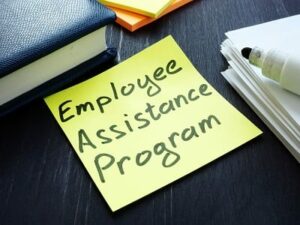Employee Assistance Programs (EAPs) are workplace-based programs designed to offer support and resources to employees facing personal and professional challenges. EAPs provide a range of services to help employees navigate life events and improve their overall well-being. In this blog, we will explore the different types of EAPs, their benefits, and how organizations can effectively implement them for their employees.
Contents
- 1 What Are Employee Assistance Programs?
- 2 What Are The Types Of Employee Assistance Programs?
- 2.1 Traditional Employee Assistance Programs (EAPs)
- 2.2 Integrated Employee Assistance Programs (IEAPs)
- 2.3 Work-Life Balance Employee Assistance Programs (WLBEAPs)
- 2.4 Critical Incident Stress Management (CISM) Employee Assistance Programs
- 2.5 Substance Abuse and Addiction Employee Assistance Programs (SAEAPs)
- 3 What Are The Benefits Of Different EAPs?
- 4 How To Implement An Employee Assistance Program?
- 5 Conclusion
What Are Employee Assistance Programs?
 Employee Assistance Programs (EAPs) are workplace-based programs designed to offer support and resources to employees facing personal and professional challenges. EAPs provide a range of services, including counseling, legal and financial advice, and support for mental health, to help employees navigate life events and improve their overall well-being. The goal of EAPs is to provide employees with the tools and resources they need to maintain their overall health and productivity.
Employee Assistance Programs (EAPs) are workplace-based programs designed to offer support and resources to employees facing personal and professional challenges. EAPs provide a range of services, including counseling, legal and financial advice, and support for mental health, to help employees navigate life events and improve their overall well-being. The goal of EAPs is to provide employees with the tools and resources they need to maintain their overall health and productivity.
EAPs are typically offered by employers as a benefit to their employees. And the services are usually provided by outside vendors on an as-needed basis. EAPs can be an effective way for organizations to support the well-being of their employees and promote a healthy and productive work environment.
What Are The Types Of Employee Assistance Programs?
There are numerous types of employee assistance programs, and out of them below are the top 5 options for you to consider:
Traditional Employee Assistance Programs (EAPs)
Traditional EAPs are the most common type of EAP and typically offer a range of services such as counseling, legal and financial advice, and support for mental health issues. These services are usually provided by outside vendors and are available to employees on an as-needed basis.
Integrated Employee Assistance Programs (IEAPs)
IEAPs are EAPs that are integrated into an organization’s overall benefits package. These programs often include additional resources. Such as wellness programs, health and wellness coaching, and work-life balance support. The goal of IEAPs is to provide a comprehensive approach to employee well-being that goes beyond traditional EAP services.
Work-Life Balance Employee Assistance Programs (WLBEAPs)
WLBEAPs are designed to help employees manage the demands of work and personal life. These programs may offer support for issues such as child care, elder care, and stress management. They may also provide resources such as flexible work arrangements and access to life coaches to help employees find a better work-life balance.
Critical Incident Stress Management (CISM) Employee Assistance Programs
CISM EAPs are designed to provide support to employees who have been affected by traumatic events such as natural disasters, workplace accidents, or acts of violence. These programs typically offer counseling, support groups, and other resources to help employees cope with the emotional impact of these events.
Substance Abuse and Addiction Employee Assistance Programs (SAEAPs)
SAEAPs are designed to support employees who are struggling with substance abuse and addiction issues. These programs may offer counseling, referrals to treatment programs, and support groups to help employees overcome their addiction. Some SAEAPs may also provide education and resources to help employees understand the effects of substance abuse and how to prevent it.
Overall, these types of employee assistance programs may provide support and resources to help employees cope with the aftermath of a traumatic event. And ultimately maintain a healthy and resilient workforce.
What Are The Benefits Of Different EAPs?
 There are several benefits of Employee Assistance Programs (EAPs) for both employees and organizations, including:
There are several benefits of Employee Assistance Programs (EAPs) for both employees and organizations, including:
- Improved Employee Well-being
EAPs provide employees with access to a range of support services, including counseling, legal and financial advice, and support for mental health issues. These services can help employees manage stress, resolve personal problems, and improve their overall well-being.
- Increased Productivity
By providing employees with the resources they need to manage personal and professional challenges, EAPs can help improve their overall health and productivity. This can lead to reduced absenteeism, higher job satisfaction, and improved performance.
- Cost Savings
EAPs can be a cost-effective way for organizations to provide support to their employees. By offering a range of services through an EAP, organizations can reduce the costs associated with absenteeism, turnover, and other work-related problems.
- Improved Workplace Culture
EAPs demonstrate an organization’s commitment to the well-being of its employees, which can help foster a positive workplace culture. By providing support and resources to help employees manage personal and professional challenges, EAPs can promote a sense of community and improve morale.
- Legal Compliance
In some cases, EAPs may be legally required for organizations to provide to their employees. For example, certain industries may be required to provide EAPs to help employees cope with the effects of workplace stress and trauma.
Overall, types of Employee Assistance Programs can provide numerous benefits to both employees and organizations. And can help create a healthier and more productive work environment.
How To Implement An Employee Assistance Program?
 Implementing an Employee Assistance Program (EAP) can be a valuable investment for an organization. But it requires careful planning and execution. Here are the steps for implementing an EAP in your organization:
Implementing an Employee Assistance Program (EAP) can be a valuable investment for an organization. But it requires careful planning and execution. Here are the steps for implementing an EAP in your organization:
- Assess Your Company’s Needs: The first step in implementing an EAP is to assess the needs of your company and employees. Consider the type of support services that would be most beneficial to your employees. And evaluate the resources that your organization can allocate to the EAP.
- Choose the Right EAP Provider: Select an EAP provider that offers a range of services that meet the needs of your organization and employees. Consider factors such as cost, accessibility, and the quality of services offered.
- Communicate the EAP to Employees: Once you have selected an EAP provider, communicate the program to your employees. Make sure they understand what services are available, how to access them, and how to make the most of the EAP.
- Train Managers and Supervisors: Train managers and supervisors to recognize the signs of stress and personal problems among employees. And to understand the role that the EAP can play in supporting employees.
- Provide Ongoing Support: Ongoing support and communication are critical to the success of an EAP. Make sure that employees are aware of the resources available to them through the EAP. And encourage them to use the program when they need it.
- Measure the Success of Your EAP: Regularly evaluate the effectiveness of your EAP and make changes as needed. Consider factors such as utilization rates, employee satisfaction, and the impact on productivity and absenteeism.
Implementing an EAP can be a complex process. But by following these steps and working closely with your EAP provider, you can create a program that meets the needs of your employees. And supports the overall well-being of your organization.
Conclusion
In conclusion, types of Employee Assistance Programs (EAPs) are workplace-based programs designed to offer support and resources to employees facing personal and professional challenges. This can provide numerous benefits to both employees and organizations, including improved employee well-being and increased productivity. Implementing an EAP requires careful planning and execution and measuring the success of the program. By investing in an EAP, organizations can demonstrate their commitment to the well-being of their employees and create a healthier and more productive work environment.
Employee wellness programs are the key to improving employee motivation, productivity, and retention. At MantraCare, we have a team of health experts, counselors, and coaches who serve corporate employees with 10+ wellbeing programs including EAP, Employee Diabetes Reversal, Corporate MSK, Employee Fitness, Corporate Yoga, and Employee meditation.
